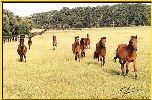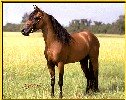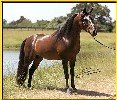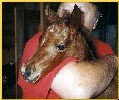breeding bay horses




Suppose we were to breed two bay horses together. We had a bay mare and stallion who were both of genotype E+e at the extension locus (E+ causes the production of the black eumelanin pigment) and of genotype AAAa at the agouti locus (which controls the distribution of black pigment).
The gametes may now be of four types, any of which are equally likely: E+AA, E+Aa, eAA or eAa. The possible outcomes of the cross can be seen from a Punnett square:
Genetic contribution from mare:
Genetic contribution from stallion:
E+AA E+Aa eAA eAa
E+AA E+E+AAAA
bay E+E+AAAa
bay E+eAAAA
bay E+eAAAa
bay
E+Aa E+E+AAAa
bay E+E+AaAa
black E+eAAAa
bay E+eAaAa
black
eAA E+eAAAA
bay E+eAAAa
bay eeAAAA
chestnut eeAAAa
chestnut
eAa E+eAAAa
bay E+eAaAa
black eeAAAa
chestnut eeAaAa
chestnut
There is a 9:3:4 of bay: black : chestnut. (The agouti allele in the chestnut horses is irrelevant to the phenotype since there is no black pigment to distribute, either uniformly or in the points.)
If either the mare or the stallion were of genotype E+E+ at the extension locus then only bay, black and brown foals would be possible according to the parents genotypes at the agouti locus.
Breeding bay horses with brown, black or chestnut horses could result in bay foals. Breeding together brown or/and black horses would only give brown or black foals.






